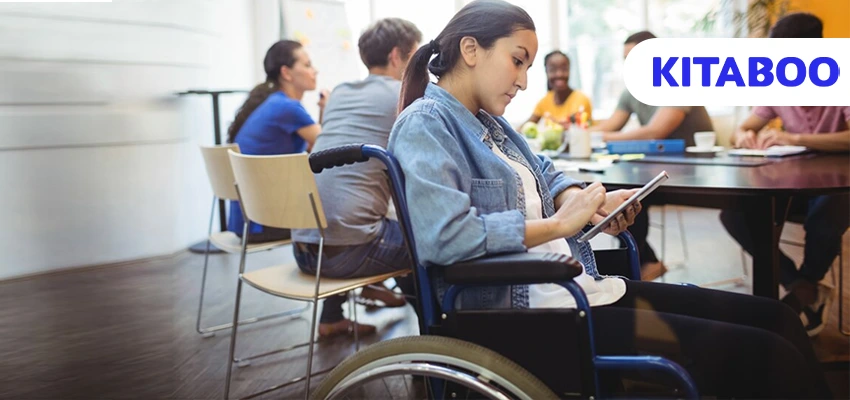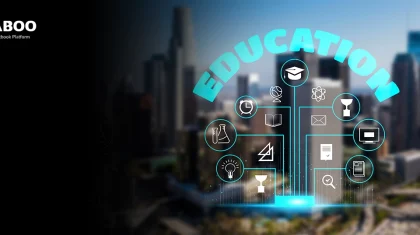
Empowering Universal, Equitable, and Inclusive Education: How KITABOO is Transforming Educational Publishing
Summarize this blog with your favorite AI:
For centuries, several demographics of learners have been deprived of an equitable and inclusive education. In particular, learners with disabilities and learning barriers have been left out of the traditional education system.
As a domino effect, they have faced challenges, especially in receiving higher education and in the area of employability.
But in the modern era, digital transformation is revolutionizing the field of education. Teachers can upend the status quo and provide everyone with an inclusive, equitable, and universal education if they have access to the appropriate technologies.
According to statistics, 7.5 million children between 3 and 21 years were served under the Individuals with Disabilities Education Act during the 2022-2023 academic year; this accounted for 15% of all students. The figure stood at 7.3 million in 2021-2022. As this number grows, digital learning platforms must be prepared to deliver an inclusive experience for these students.
Table of Contents:
I. Understanding Universal, Equitable, and Inclusive Education
II. How Can Digital Learning Platforms Enhance Inclusivity and Equity for Their Learners?
- Make Learning Resources Accessible to All
- Embrace the Concept of Universal Design
- Leverage Multiple Content Formats
- Deliver a Mobile-first Experience
- Harness Personalized Learning Journeys
- Introduce Multi-language Education
- Leverage the Power of Data Analytics
III. To Wrap Up
Understanding Universal, Equitable, and Inclusive Education
A universal, equitable, and inclusive education refers to a learning model that enables all learners to reap the benefits of equal access and opportunity for effective learning.
With education policy moving in this direction, more educators and digital learning platforms are gearing up to nurture learning access for all users.
This model of education is possible thanks to advances in technology that enable an accessible learning experience. For instance, the use of a single, unified AI-powered textbook publishing platform such as KITBOO paves the way for making all learning experiences inclusive, universal, and equitable.
Also Check: Digital Publishing Solution for Content Aggregators
How Can Digital Learning Platforms Enhance Inclusivity and Equity for Their Learners?
Here’s how digital learning platforms can enhance inclusivity and equity for their learners:
1. Make Learning Resources Accessible to All
The first pillar of shaping a universal, equitable, and inclusive education is crafting an accessible user journey. This means that the learning platform must be easily accessible to people with hearing, visual, mobility, and motor disabilities.
The platform must also cater to students with learning challenges, such as reading difficulties.
Here are some examples of popular accessibility features and tools that power inclusive learning:
- All images must have ALT TEXT, a brief description of the visual’s content.
- Videos must have captions and subtitles in relevant languages.
- Access to Text-to-Speech (TTS) tools helps learners with conditions such as dyslexia, visual limitations, and motor challenges by automatically turning text on a page into spoken words. This feature can be useful in assessments, engagements with chatbots, and other contexts.
- Read Aloud is a feature that enables audio representations of text-heavy content such as blogs.
- Easy adjustment of screen brightness and the font size and font style of text as per learner preferences.
- Learners with disabilities must also be able to navigate the platform and discover content intuitively.
2. Embrace the Concept of Universal Design
Digital learning platforms can enhance inclusivity by adopting universal design principles, ensuring that all content is accessible to individuals with varying abilities and learning needs.
Rather than creating separate resources for different learners, universal design allows the same content to be usable by everyone, regardless of their limitations. This approach streamlines content creation, enabling educators to deliver an equitable experience for all students while also optimizing operational efficiency, saving both time and resources.
3. Leverage Multiple Content Formats
Content diversity gives learners choices. They can select the content format they feel most comfortable with. Introducing game elements and live simulations further increases interactivity. Learners can absorb and retain knowledge and skills much faster and more effectively.
Educators must consider presenting content in diverse formats. These include video and audio representations, interactive eBooks, slide shows, podcasts, and 3D models, to name a few.
4. Deliver a Mobile-first Experience
Today, a growing number of learners prefer to learn from the comforts of their mobile phones. As of 2025, the USA boasts 310 million smartphone users and a 96% smartphone penetration rate.
The sheer numbers indicate that digital learning platforms must focus on building a mobile-first learning experience. Smartphones also come with their own accessibility tools, which make them the go-to device for learners seeking a universal, equitable, and inclusive education experience.
5. Harness Personalized Learning Journeys
Today, learners prioritize user journeys that enable them to learn at their own pace. By adopting a digital textbook publishing platform, educators can personalize user experiences.
By automating the personalization process with AI and machine learning, these systems give students tests and materials that are tailored to their individual requirements and skill levels. For students with impairments and learning difficulties, this method is especially helpful because it guarantees they get the assistance they need to study effectively.
6. Introduce Multi-language Education
Language is a major barrier for a large spectrum of people for whom English is not their native language. By offering multi-language support, digital educational platforms can be more inclusive and attract learners with a diverse language base. Learners can also absorb and retain knowledge much faster when they can access the content in their native language.
7. Leverage the Power of Data Analytics
Digital learning platforms must utilize the power of data analytics to boost learner engagement and effectiveness. For instance, they can have access to learner data such as engagement preferences, frequency of engagement, login and logout timings, assessment data, and accessibility features used.
Based on the data, educators can more thoroughly understand learner trends, challenges, weaknesses, and strengths. They can, in turn, revise the curriculum and introduce new learning content.
Using a Learning Management System (LMS) driven by AI enables educators to monitor student progress and remain flexible and attentive to changing user requirements.
By adhering to these principles of inclusive, egalitarian, and universal education, KITABOO enables teachers to design dynamic, easily accessible, and customized learning environments that cater to the various requirements of every student. This way, it creates a more equitable education space, ensuring that every learner, regardless of their background or abilities, has the opportunity to thrive.
To Wrap Up
By utilizing the power of a superior AI-powered LMS, educators can craft accessible, personalized, interactive, and multi-language learning experiences. They can cater to diverse students, capture greater market share, boost learning effectiveness, turn more leads into learners, and enjoy higher retention rates.
If your digital learning platform aims to revamp its entire system and shift towards universal, equitable, and inclusive education, you can accelerate growth efficiently and swiftly with the right technology.
KITABOO, as an innovative digital textbook publishing platform, offers the tools, in-built analytics, and expertise to help educators deliver impactful, accessible learning programs at scale.
Whether you’re looking to enhance accessibility, introduce personalized learning journeys, or expand into multi-language content, KITABOO can guide you every step of the way.
Request a demo to learn more!
Also Check:
Discover how a mobile-first training platform can help your organization.
KITABOO is a cloud-based platform to create, deliver & track mobile-first interactive training content.



